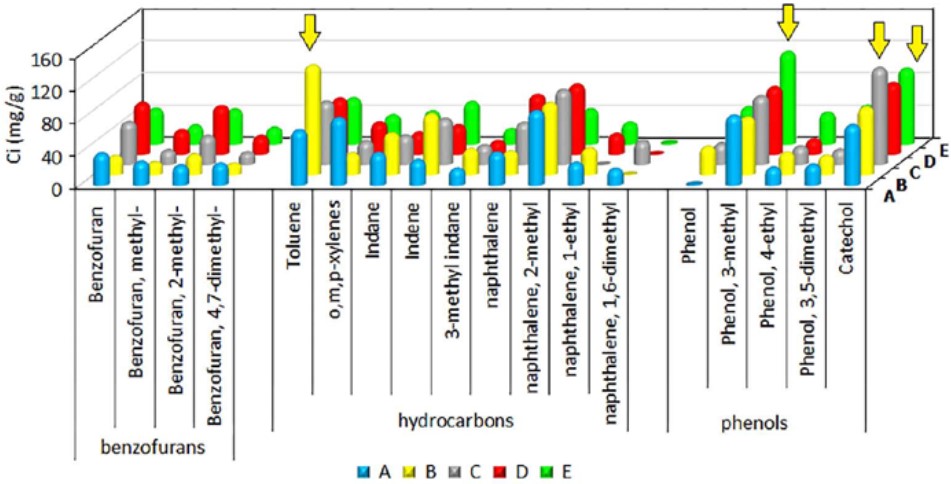Oxygenated Semi-Volatile Ingredients Analysis Service in Bio-Oil
Analysis of Oxygenated Semi-Volatile Components in Bio-Oil at Creative Biolabs
Bio-Oil is usually extracted or produced from biomass raw materials such as plants, animals, or microorganisms. These biological sources contain rich organic substances such as fatty acids, carbohydrates, etc. These organic substances may produce various semi-volatile oxygenated ingredients during bioconversion and extraction, including organic acids, alcohols, ethers, and other compounds. These ingredients play a vital role in bio-oil and affect the properties and applications of bio-oil. Analysis and identification of semi-volatile oxygenated ingredients in bio-oil helps to determine the chemical composition, stability, and combustion characteristics of bio-oil and provides key information and support for product optimization, process improvement, and new application development. Creative Biolabs has an experienced and highly qualified professional technical team that accurately analyzes semi-volatile oxygenated ingredients. And provide personalized analysis services according to different bio-oil types and client needs.
We dissolve the bio-oil sample in an appropriate solvent. Ensure that the sample processing process avoids the introduction of external contaminants as much as possible. Then the sample is extracted, washed, concentrated, and other steps to better separate and detect semi-volatile oxygenated ingredients.
We analyze the semi-volatile oxygenated ingredients in bio-oil by using techniques such as gas chromatography-mass spectrometry (GC-MS), high-performance liquid chromatography-mass spectrometry (HPLC-MS), and high-performance liquid chromatography-ultraviolet detection (HPLC-UV). We optimize the chromatographic conditions by adjusting the mobile phase composition, flow rate, column temperature, elution gradient, and other parameters according to the analytical requirements. These conditions are essential for the effective separation and detection of the target ingredients. Next, we introduce the treated sample into the chromatographic system through the injection port so that the compounds in the sample are separated. In HPLC, compounds are separated in the stationary phase according to their affinity and distribution coefficient, and compounds are separated in the gas phase column according to their volatility and affinity by GC-MS.
-
Detection and identification
We use MS or UV detectors to detect the signals of various compounds in the sample and identify the compounds according to the signal characteristics. Some common semi-volatile oxygenated ingredients in bio-oil include phenolic compounds (such as phenol, catechol), aldehyde compounds (such as benzaldehyde, furfural), ketone compounds (such as acetone), carboxylic acid compounds (such as acetic acid, butyric acid), etc.
We process and analyze the detected compounds, including peak area calculation, and qualitative and quantitative analysis of compounds, to determine the content and type of semi-volatile oxygenated ingredients in bio-oil.

Creative Biolabs closely follows the development of the industry, constantly updates analysis methods and technologies, and always maintains a leading position in the field of bio-oil analysis. In addition to providing analysis for semi-volatile oxygenated ingredients, we also provide Analysis of Glycans in Bio-Oil Water Extract. If you need to obtain detailed analysis details, please do not hesitate to contact us immediately. We will pay attention to your needs and provide you with high-quality bio-oil-related analysis services.
Published data
Bio-oil produced by biomass pyrolysis is used to produce biofuels or chemicals. Its chemical composition is complex and contains many different compounds. Therefore, it is necessary to quantify the various components of bio-oil to support the corresponding product development and industrial application. In this study, the authors used GC-MS technology to analyze the common volatile and semi-volatile compounds in five bio-oil samples. They used 16 standard samples to construct a standard curve by the internal standard method and then identified 196 compounds in the bio-oil samples through appropriate separation conditions. Moreover, 49 compounds were quantitatively analyzed, including benzofuran, aromatics, naphthalene, catechol, etc. The results showed that the most abundant compounds in bio-oil were catechol and m-cresol.
 Fig.1 Distribution of compounds in different bio-oil samples.1, 2
Fig.1 Distribution of compounds in different bio-oil samples.1, 2
FAQs
Q1: What is the principle of your analysis method?
A1: Our analysis method is usually based on chromatography-mass spectrometry (e.g. GC-MS). We identify and quantify semi-volatile oxidized ingredients in bio-oil by chemical separation and mass spectrometry detection.
Q2: What is the detection range of these semi-volatile oxidized ingredients in bio-oil?
A2: Our analysis methods usually cover a variety of semi-volatile oxidized ingredients, including aldehydes, ketones, phenols, etc. The specific detection range depends on the selected analysis method and instrument.
Q3: What information will your report include? Can quantitative data be provided?
A3: Our report usually includes a list of identified semi-volatile oxidized ingredients, relative content or quantitative data, and possible conclusions or recommendations.
Customer Review
The Professional Team Provided Excellent Bio-oil Analysis Services
"Our experience with this service was outstanding. The in-depth analysis of bio-oil components provided by their expert team was pivotal in advancing our understanding of our product. We highly recommend their services to anyone in need of precise analytical solutions."
Timely Delivery of Semi-volatile Oxygenated Component Analysis Results
"The Creative Biolabs team's professional analysis and timely delivery of results made our cooperation smooth and efficient. Their analysis of semi-volatile oxygenated ingredients was crucial to the success of our project, and we look forward to working with them again in the future."
References
-
Santos, Anai L. dos, et al. "Quantitative GC-MS Analysis of Sawdust Bio-Oil." Journal of the Brazilian Chemical Society 34.11 (2023): 1581-1591.
-
Under Open Access license CC BY 4.0, without modification.
For Research Use Only.
Related Services


 Fig.1 Distribution of compounds in different bio-oil samples.1, 2
Fig.1 Distribution of compounds in different bio-oil samples.1, 2

